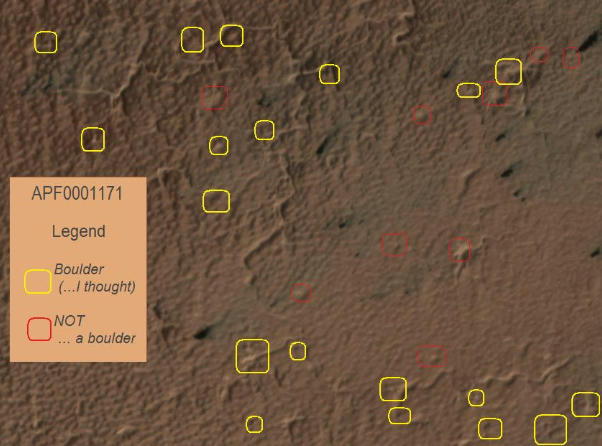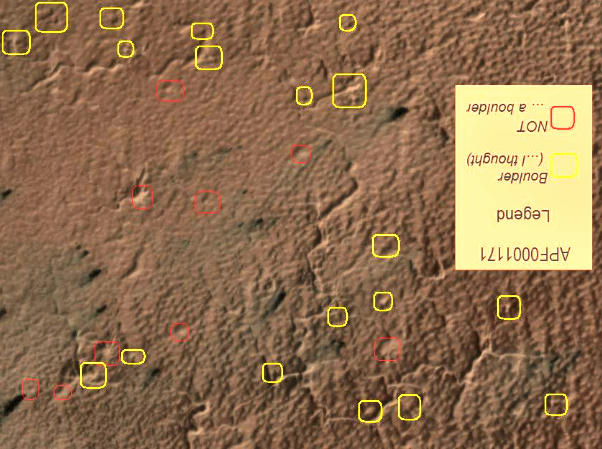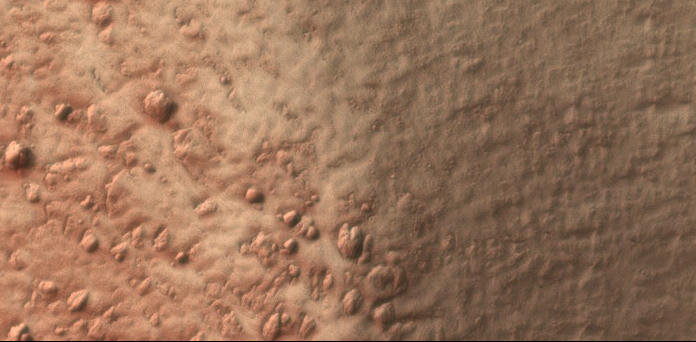Boulders? - APF0001171
-
 by
EA2014
by
EA2014
THANKS for your comments, Jelly! Hope this gives you the link to the actual image APF0001171
~ElizabethPosted
-
 by
p.titchin
in response to EA2014's comment.
by
p.titchin
in response to EA2014's comment.
Can't see any exposed boulders,or clusters thereof. Can you point to where they are? thanks ~ Pete.
Posted
-
 by
JellyMonster
by
JellyMonster
I think Elizabeth's imagination is running riot :p
Here is the image (with markings) she sent me. Below that is the same but with a few edits (one very obvious).


Posted
-
 by
EA2014
in response to JellyMonster's comment.
by
EA2014
in response to JellyMonster's comment.
Jelly & Pete ...admittedly, I've never been accused of LACKING imagination 😃 ! ...ha-ha!
Obviously there are the lovely round boulders that are frequently seen with a dark halo of material and sometimes even a fan or venting (but they don't exist in this image, that I can see).
I was operating under an assumption (...or "delusion") that there was more than one type (for the sake of the explanation, I'll call it "object-B").
Characteristics of an "object-B":
-
they're associated with spiders;
-
they're not necessarily symmetricially 'round';
-
they're emerging from or forming from the terrain;
-
they occur adjacent to at least one depression (I'd post an example but haven't figured out how to, yet).
Now, having said that - it may be that "object-B" types should even be called something else besides 'boulders'! It's also VERY possible that these formations aren't even important to the questions the Scientists are trying to answer!! ( .......in which case - I'll just quietly sneak off, wear a disguise and not mark them anymore ........ 😃 )
~Elizabeth (... hum - I could change my name, too .....)
Posted
-
-
 by
wassock
moderator
by
wassock
moderator
Fret not Elizabeth (who's the foxy lady in your new avatar?) , for my money the key to boulders is that they are raised and cast a shadow which is on the opposite side to where the shadows lie in the spiders.
Posted
-
 by
EA2014
in response to wassock's comment.
by
EA2014
in response to wassock's comment.
..that's my new disguise (...you're TOO kind, wassock!). One thing for sure is - that these features are VERY intriguing!!!
Posted
-
 by
EA2014
by
EA2014
... and then there's APF0001018 (as a good example of intriguing)
Boulder? Hill? Mound? ???
Posted
-
 by
p.titchin
in response to JellyMonster's comment.
by
p.titchin
in response to JellyMonster's comment.
Thanks Jelly, that's a huge help. I agree with your 'Not boulders', and have tentatively queried objects like some of your 'boulder' marked bumps as '? emerging boulders'. My problem in these 'pimple' mars-scapes is how many of the 'pimples' might be ice embedded boulders. They are very regular in size and distribution, and at present I can't visualize a boulder field like that. Wassock's shadow test is very good for distinguishing bumps/hills/boulders from spiders/channels/ craters/hollows, but if it's raised enough, it will have a shadow, whether boulder, emerging boulder, rocky outcrop or hillock. -- In the exposed terrain, I have not seen any images that might give the pimple appearance terrain when ice covered. All adds to the ongoing fun! ~Pete
Posted
-
 by
p.titchin
in response to EA2014's comment.
by
p.titchin
in response to EA2014's comment.
3 more for you Elizabeth, APF00010yt , APF0000znn , and APF000105m . 😃 ~Pete
Posted
-
 by
JellyMonster
in response to p.titchin's comment.
by
JellyMonster
in response to p.titchin's comment.
Pete, they are not my boulder marked bumps, they are Elizabeth's.
Posted
-
 by
JellyMonster
in response to EA2014's comment.
by
JellyMonster
in response to EA2014's comment.
Meg called it a 'maybe boulders' so even she isn't sure. Image APF0001018 has been rotated through 180.

Posted
-
 by
Kitharode
moderator
by
Kitharode
moderator
I can't get away from thinking that these objects are bumps, rather than boulders. They seem to me to be 'remnants' of an eroded surface, or exposed bumps of an underlying layer. Obviously I could be wrong.
Inca City is a bit of an anomaly, as you know, being part of a very large impact crater which has been filled/covered and re-exposed by erosion (so the theory goes). Its location puts it outside the spld's, so the underlying geology (I'm guessing) will be very different from other areas of interest, eg, Ithaca, Manhatten, etc.
Good discussion ... Well done everybody. 😃
Posted
-
 by
p.titchin
in response to JellyMonster's comment.
by
p.titchin
in response to JellyMonster's comment.
Sorry Jelly, I responded to your avatar, having been drawn straight to the images. I must learn to 'read the writing', not just 'look at the pictures' !! 😃.
- Apologies Elizabeth, as you will gather from my mistaken reply to Jelly, I'm not sure that the objects you have marked as boulders are boulders, or just lumps or outcrops in the underlying terrain.
- In our Inca city images , the round 'boulders' are common, (nickname, 'snowballs') but like your image , the three images I posted for you show the more irregular shaped lumps or 'boulders', which have the appearance of 'emerging from the ice. I have been wondering whether the round boulders have an irregular core whose outline has been softened by a covering of ice and come to appear more rounded, just as we see on earth when highly irregular objects are covered by snow. I'm sure there are many types of object we are loosely tagging as boulders. Its just fun speculating! ~Pete.
Posted
-
 by
wassock
moderator
by
wassock
moderator
The one's I've been able to track down in both summer and iced conditions look just the same either way, so for my money they're not icy or at least not such that HiRise can resolve the difference. The latest bunch look more like conflakes than boulders to me.
Posted
-
 by
EA2014
in response to p.titchin's comment.
by
EA2014
in response to p.titchin's comment.
Hello, Pete -
The 3 additional images you sent are indeed fascinating. Thanks very much! Considering those types of conflakes (cornflakes?), as wassock has dubbed them (good call! 😃 ) - certainly makes you wonder if sunlight is a factor...Now that I've been doing this for a couple of months (& obviously, still quite the 'newbe') - I'm slowly noticing more details that I wished I'd noted somehow!! - for instance, I've repeatedly seen a type of 'very circular' feature (boulder?) on a certain type of terrain. In a specific image, their sizes were about the same & they were spaced at rough intervals and often formed an arc (& sometimes an arc within another arc). I'd wondered if they were related to old impact craters that were no longer visible (how's THAT for pulling a rabbit out of a hat!) ..... Jelly is probably saying: "there goes the imagination, again" 😃
But I certainly agree with you Pete: it IS fun to speculate AND the 'Boulder' tag is probably being attached to a number of different objects - I've certainly done my part! ..... but 'sifting & sorting & marking' is what we do and it seems to be just part of the process. The 'paycheck' for me - is listening to the ideas & debates about the work we've done 😃
Well, back to the cornflakes - but now, I'm hungry. Thanks again! ~Elizabeth
Posted
-
 by
EA2014
in response to JellyMonster's comment.
by
EA2014
in response to JellyMonster's comment.
Jelly, the great version of APF0001018 you posted certainly makes me wonder if anything is actually a 'boulder'! No wonder even Meg said "maybe"...... lots to think about!!!
~Elizabeth
Posted
-
 by
JellyMonster
by
JellyMonster
Have you noticed that the 'cornflake' activity is much more apparent on the lighter region or higher plain. Is this significant? Elizabeth wondered if sunlight were a factor. It's no good asking me 😛
Posted
-
 by
Kitharode
moderator
by
Kitharode
moderator
Cornflakes - I like it.
Elizabeth: Are your 'curved' boulder images like this? http://talk.planetfour.org/#/subjects/APF0000hm3
Posted